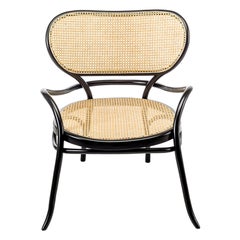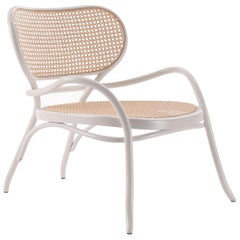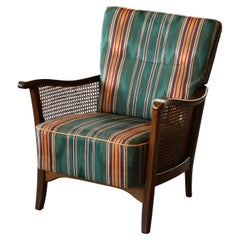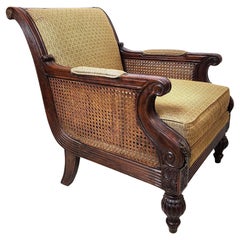Adolf Loos Lounge Chairs
Essentially dubbed the Frank Llyoyd Wright of Europe by Wright himself, Adolf Loos possessed a talent for architecture and interior design as potent as his outspoken criticism of Art Nouveau and excessive ornamentation. A forerunner of the International Style, Loos exercised immense restraint in his building projects as well as his designs for chairs, tables, storage pieces and other furniture, and wrote prolifically on his disdain for taking a decorative approach to architecture.
The son of a stonemason and sculptor, Loos was born in 1870 in what is now Brno in the Czech Republic. He studied architecture in Dresden in 1889, completed a year of military service and moved to the United States by 1893. He visited the World’s Columbian Exposition in Chicago and came to appreciate the American approach to design over his three-year stay before returning to Vienna.
An avid proponent of simplicity, Loos hated fluff above all else. In his best known essay, “Ornament and Crime,” he states “the evolution of culture is synonymous with the removal of ornamentation from objects of everyday use” — a principle evident in both his architectural work and furniture. His writing was profoundly influential for practitioners of the International Style that would emerge later as well as the likes of prolific Swiss-born French architect and modernist prophet Le Corbusier.
Loos challenged the prevailing architecture and decorating styles of his time, and disliked the ornate work associated with the Vienna Secession and Gesamtkunstwerk — the concept of a house as total work of art — an ideal pursued by a collective born from the Secession called the Wiener Werkstätte. To Loos, design should prioritize function, and any ornamentation devoid of a structural purpose was childish and unnecessary.
Loos’s furniture — alongside the work of fellow Austrian architect Josef Hoffman — was the subject of an exhibition at the Museum of Applied Arts in 2014. His architecture projects, including the Viennese Goldman and Salatsch building, the Austrian Steiner House and the Villa Müller in Prague, are celebrated by design enthusiasts all over the world.
Find vintage Adolf Loos seating, lighting and other furniture on 1stDibs.
21st Century and Contemporary Austrian Modern Adolf Loos Lounge Chairs
Wood
21st Century and Contemporary Austrian Modern Adolf Loos Lounge Chairs
Wood
1960s Danish Mid-Century Modern Vintage Adolf Loos Lounge Chairs
Cane, Beech
1970s Vintage Adolf Loos Lounge Chairs
Cotton, Cane, Mahogany
Late 19th Century Austrian Art Nouveau Antique Adolf Loos Lounge Chairs
Beech, Bentwood
21st Century and Contemporary American Mid-Century Modern Adolf Loos Lounge Chairs
Rush, Walnut
Early 20th Century Austrian Biedermeier Adolf Loos Lounge Chairs
Beech
1970s Austrian Mid-Century Modern Vintage Adolf Loos Lounge Chairs
Chrome, Metal
Early 1900s Austrian Art Deco Antique Adolf Loos Lounge Chairs
Bentwood
1970s Unknown Mid-Century Modern Vintage Adolf Loos Lounge Chairs
Cotton, Reed
20th Century Art Nouveau Adolf Loos Lounge Chairs
Wood
21st Century and Contemporary American Modern Adolf Loos Lounge Chairs
Rope, Hardwood
2010s American Mid-Century Modern Adolf Loos Lounge Chairs
Leather, Oak, Walnut
21st Century and Contemporary Italian Modern Adolf Loos Lounge Chairs
Stainless Steel
Adolf Loos lounge chairs for sale on 1stDibs.
- What is Adolf Loos famous for?1 Answer1stDibs ExpertJanuary 10, 2025Adolf Loos is famous for his achievements as a designer. Essentially dubbed the Frank Lloyd Wright of Europe by Wright himself, he possessed a talent for architecture and interior design as potent as his outspoken criticism of Art Nouveau and excessive ornamentation. A forerunner of the International Style, Loos exercised immense restraint in his building projects as well as his designs for chairs, tables, storage pieces and other furniture. He wrote prolifically on his disdain for taking a decorative approach to architecture. Explore a variety of Adolf Loos furniture on 1stDibs.



